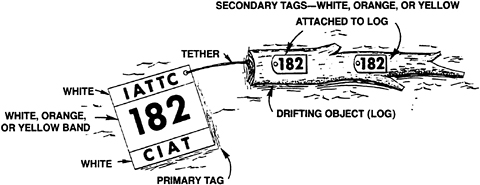NOTICE TO FISHERMEN
Tagged Drifting Objects
The Inter-American Tropical Tuna Commission (IATTC) will be tagging drifting objects, such as tree trunks, branches, etc., off the Colombian coast during August and September of 1987. The IATTC will also attempt to tag tunas associated with these objects.
The purpose of this project is to monitor the movement of drifting objects in the eastern Pacific tuna fishing grounds and to study the association of tunas with these objects.

Primary tag: One plastic floating square, 2 ft × 2 ft × 3/16 in, tethered to the object.
Secondary tag(s): One or more colored plastic tags, 6 in × 4 in, attached directly to the drifting object.
If you see any of these tagged drifting objects, please:
-
Record in your logbook and notify one of the offices on the back of this page, the following information:
-
Tag number (or color if number cannot be seen), and the condition of the tags
-
When and where it was sighted
-
Abundance of fish around it
-
Condition of the drifting object
-
-
Do not remove the tags from the log, as there is no reward for them.
Inter-American Tropical Tuna Commission



